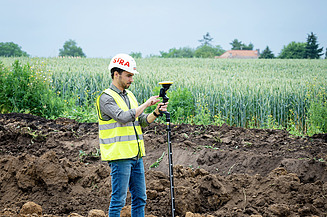Progress through technical pioneering

What is your function at STRABAG?
As a BIM expert at STRABAG Innovation & Digitalization (SID), I organize and support the BIM pilot projects in the Group together with the operating units and am responsible for the Czech Republic and Slovakia from Vienna. Brandýs was one of these pilot projects. My role was to organize the whole development, to bring the tools to the project site so that the colleagues outside have everything they need for their work. Together with other colleagues from SID, I trained the people on the construction sites and showed them the tools and technology.
What was special about the project?
We successfully used BIM2Field in traffic route construction during the construction of the bypass in the Czech town of Brandýs. Thanks to BIM2Field, what previously had to be planned laboriously on countless 2D construction plans is now simply and digitally available. This not only facilitates and accelerates the workflow, but also makes it more sustainable, because BIM2Field stands for a paperless construction site. In addition, the BIM model improves the planning quality through the constant flow of information and thus ensures a more efficient construction process. On the construction site, various digital tools are interlinked: model-based planning and the processing of drone and satellite data enable machine control via GPS and the visualization of completed and upcoming work in augmented reality. All information is extracted directly from the BIM model and made digitally available to the colleagues on the construction site.
What can be optimized by this technology?
We are significantly more effective. In machine control, for example, the figures show how much faster and more accurate we can work when we realize our roads and projects in the same way as in Brandýs. We have achieved a significant increase in effectiveness there. I walk across the construction site and can see in augmented reality at any time what the site will look like in the near future and what work is still outstanding. I can see what has not yet been finalized, read off distances in the model and call up all the data on my current position on the construction site. It also serves as a quality assurance tool to help us identify planning errors at an early stage. In this way, we are demonstrating how complex projects in traffic route construction can be digitized and thus made more efficient and sustainable.
What does "work on progress" mean to you?
When I look at other industries and sectors, the construction industry tends to lag behind when it comes to digitization. We want our colleagues out on the construction sites to be able to work more efficiently and sustainably. There is huge potential to optimize processes through innovative ideas and digital tools. I believe we can still make a big difference if we bring technologies like these to our construction sites.